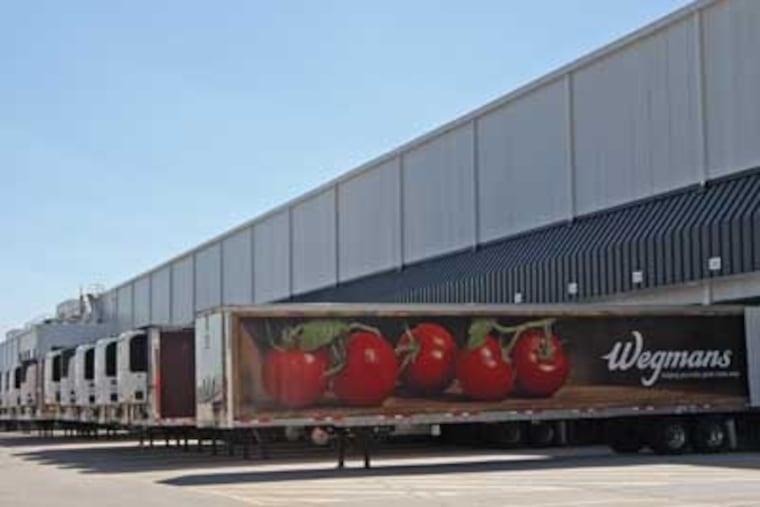Wegmans completes last wing of Pottsville distribution center
POTTSVILLE, Pa. — It’s a sprawling warehouse nearly one million square feet, with 103 loading docks for tractor-trailers to be filled with groceries that will eventually make their way to Wegmans supermarkets.

POTTSVILLE, Pa. — It's a sprawling warehouse nearly one million square feet, with 103 loading docks for tractor-trailers to be filled with groceries that will eventually make their way to Wegmans supermarkets. And now, a decade after plans were first unveiled to build the gargantuan hub in Pennsylvania instead of Maryland, the complex that will fuel the popular chain's continued growth is finished.
Over the last several weeks, Wegmans has been bringing up to speed the final wing of its Retail Service Center, its only supply hub outside Rochester, N.Y., where the company is based. With it, officials said, Wegmans is better poised than ever to serve existing stores in Pennsylvania and New Jersey and to open others in markets that are becoming its southern frontier — Maryland and Virginia.
Located in a business park near the rolling green hills of the Appalachians north of Reading, the warehouse is tantalizingly close to Interstates 78, 81, and 80, major commercial corridors that made the site particularly attractive compared with rivals in Pennsylvania and Maryland, officials said. Route 15 into Maryland is not too far away, either.
Another reason Wegmans plunked down its three-phase megaplex at Highbridge Business Park (home also to distribution hubs for Wal-Mart and Lowe's) is purely financial: The company received roughly $4.8 million in grants and tax credits from the administrations of Govs. Tom Ridge and Ed Rendell. In addition, real estate tax abatements were green-lighted on the local level, said Frank J. Zukas, who helped coordinate the aid packages as president of the Schuylkill Economic Development Corp. (SEDCO).
"This is the single biggest project that our company has ever taken on," said David DeMascole, who got his start 34 years ago trimming lettuce in a Wegmans produce department and is now general manager of this highly sophisticated clearinghouse of merchandise. "Over $140 million is what we're sitting on today."
"Pennsylvania has been fantastic for us — and we for them," said Mike Mullen, senior vice president of distribution for the family-owned chain, which employs 42,000 people at stores in Pennsylvania, New Jersey, New York, Virginia, Maryland, and Massachusetts. "This has been a very business-friendly state for us."
That sort of enthusiasm from retail prospects is what Zukas had in mind when his group, which acts as a developer to help promote growth in otherwise rural Schuylkill County, began plans to build the business park that is now home to warehouses for Sara Lee and others.
With $15 million in help from the state Department of Transportation, SEDCO saw to it that an exit was constructed off nearby I-81, Zukas said — in 1999, Exit 119 for Highridge Park Road was built.
With Lowe's later settled in as the first anchor tenant, Wegmans agreed in 2002 to begin what would be a 10-year project to build its own formidable facility, which accommodates dry goods and temperature-sensitive groceries.
Three phases of construction came to an end with the completion this year of a 492,000-square-foot refrigerated and frozen wing. The warehouse, said DeMascole, would be "the engine" for the company's growth.
With the opening earlier this month of a Wegmans in King of Prussia, the company's investment was already producing dividends: Warehouse personnel were sending out trucks day and night with grocery shipments to meet demand at the new store along Route 422, DeMascole said.
Wegmans rings up more sales per store than anyone in the industry, according to company officials. That intensifies the need to replenish merchandise with new deliveries on a daily basis.
For years, all perishables sent to its supermarkets in and around Pennsylvania were trucked all the way down from Rochester, where the chain has its only other distribution center. That's costly and, in times of bad weather, less reliable than having a center closer to actual stores.
The newly completed Pottsville location, of course, has made such long treks unnecessary, and resupplying easier and cheaper, company officials said.
The first phase of the complex — a 150,000-square-foot produce facility — opened in 2004, and a 300,000-square-foot wing for dry grocery goods debuted in 2005. The 492,000-square-foot refrigerated and frozen warehouse has been brought on line gradually this year.
That $70 million cold-storage facility has soaring ceilings and is kept at temperatures that change as you walk through it. At one end, the thermostat is set just above freezing at all times; at the other, it's subfreezing. This area was tailored to receive and ship meat, baked goods, seafood, ice cream, deli items, dairy, and prepared foods.
With 529 nonunion Wegmans employees, the distribution center is unlike the one in Rochester, where part of the workforce has long been represented by unions. (The company has been around for nearly a century.) Over the last eight years, the southern outpost has moved mounds of merchandise, relying overwhelmingly on in-house employees, a supplemental crew of contracted drivers for busier periods, and an outsourced maintenance force.
To date, the warehouse has been a busy crossroads of grocery distribution, even as the chain has conservatively added up to three new stores a year to its holdings.
"We shipped over one million cases," DeMascole said, "from this facility to our stores throughout the company."